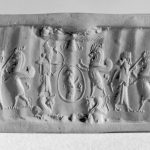A small round cylinder, usually made of a kind of mineral or other stone, engraved with images and occasionally also text (in cuneiform script). The cylinder seal was rolled over wet clay to create a seal impression. Since one could keep on rolling continuously, one could cover a larger surface than with a stamp seal, which was also used in Neo- and Late-Babylonian times. A person could roll (or stamp) his seal on a document to prove ownership or his identity. A sealing thus functioned a bit like a signature nowadays.
Image: An impression of an Iranian cylinder seal (ca. 550-330 BCE) depicting the king fighting a lion-griffin.
Source: Walters Art Museum (CC0).
(CC0).